I hear some groans with the mention of this plant because it is so hard to get rid of in the garden. Up until now I’ve not valued Oxalis at all as an edible weed. I’ve viewed it as containing too much oxalic acid for eating (the same substance in silver beet and spinach which we are told to eat in moderation) and a nuisance in the garden, where I try compulsively to get every last bulb out – an impossible task. That is the only way I have found that works to lessen the bulbs. The idea to keep hoeing off the leaves to deprive them of food and then they eventually give up and die, has not worked. We don’t spray either, so that means accepting them or taking the time to get the bulbs out. Not all species of oxalis have the bulbs, instead they have thick, fleshy rhizomes. This species often grows in shady places where not much else grows and they are filling in an empty place and I think they look decorative with their three leaves, each heart shaped that have distinctive
creases down the middle. Both leaves and flowers can fold up at night or in rough weather. Oxalis purpurea in the photo however, has rounded leaves and are not heart shaped.
I’ve had two recent occasions that have brought Oxalis to my attention in a positive way. Firstly, I went to Muriwai beach where I had a new experience of staying in a very cosy, self contained AirB&B cottage. From the cottage I explored the surroundings before
running an edible weed workshop just down the road. I was fascinated with what grew in the sandy soil near the beach. Popping their heads up through the
kikuyu and providing some colour on the scene were bright pink Oxalis purpurea flowers. Another patch of them with rounded clover shaped leaves looked very pretty growing in the mown lawn of the camp ground. Another species Oxalis pes-caprae or Bermuda Buttercup grew also through the kikuyu with clusters of yellow flowers. I ate a
couple of the flowers and found they had a very nice lemony flavour.
Secondly, last Wednesday I attended the Agricultural Field Days at Mystery Creek, near Hamilton, for the very first time and had no idea how vast it is. I specifically went to see Belinda MacDonald and Neena Truscott 2014 winners of “My Kitchen Rules”. They ran four food demonstrations and I wanted to see how they use ‘weeds’ in their recipes. Up on stage in a prime spot was a clay pot of Oxalis or ‘Wood Sorrel’ as they called it. Turns out Oxalis is Greek for sorrel. Other names are ‘sourgrass’ or ‘pink shamrock’ (However real Irish Shamrock is white clover). Belinda and Neena were raving about the lemony, tangy flavour of ‘wood sorrel’ and the audience got to try it as a garnish on the finger food they prepared, surprising many people how good it tasted!
I’m often told by people on weed workshops that they ate oxalis as children and liked the flavour of the leaves. They were getting a dose of Vitamin C and Vitamin A as the leaves are rich in both. I’ve discovered that in moderation oxalis can be used in lots of dishes for example the leaves tossed in salad and the flowers as a garnish. It goes well with root vegetables, fish and chicken and the oxalic acid is lessened in cooking. I’m going to try it in a roast pumpkin salad with a creamy dressing. You could also try it in an apple, peach or pear pie or crumble, for a flavour like rhubarb. I made a humus out of runner beans (I even peeled them). A good way to use those beans in cases left on the plant at the end of season which can be shelled and turned into a delicious dip on my seed bread with oxalis as a garnish.
Runner Bean Humus
1 1/2 cups of cooked runner beans (peeled if the beans have a tough skin)
4 cloves garlic
4 T olive oil
Juice of 1 lemon
1/2 tsp salt
Method
Peel the garlic and smash in a food processor, add the beans, lemon juice, oil and salt and continue processing until you have a nice smooth paste. You can add more oil or juice if it is too thick.
Seed Bread Recipe (inspired by Pete Evans http://peteevans.com)
3 T sunflower seeds (activated by soaking, then re-drying in a dehydrator or slow oven)
3 T pumpkin seeds (activated by soaking then re-drying)
1 T chia seeds
1/2 cup almonds (activated as above)
1.5 cups almond meal or walnut meal
3 T LSA (I don’t use linseed so I ground 1 T each of almonds, chia and sunflowers)
1 tsp bicarbonate of soda
2 T coconut flour
6 organic eggs
1 T honey (optional – I don’t add)
1 T raw cider vinegar
4 T coconut oil melted
1 tsp sea salt
1 T dried weeds such as mallow or galensoga
Method
1/ Heat oven to 160 Celsius. Grease and line a loaf tin with baking paper.
2/ Mix the sunflower, pumpkin seeds and chia seeds in a large bowl. Stir into it
almonds, almond or walnut meal, your version of LSA, bicarb, powdered weeds and coconut flour.
Add eggs, honey (if using), vinegar, coconut oil and salt and mix to combine it all. The mixture looks more like a batter than a bread dough.
3/ Pour the batter into the prepared loaf tin and smooth out with a spatula. Sprinkle extra seeds or poppy seeds on top. Bake for 45-50 minutes, until a skewer comes out clean. Remove from the oven and allow to cool in the tin before turning out.
This stores up to 5 days Pete says in the fridge or up to 3 months in the freezer.
I slice it and freeze two slices in a sandwich bag and take them out as needed.
The green in the bread photo is pumpkin seeds and the mallow which swells in the batter.
Use a slice with bean humus and garnish with oxalis for extra flavor. Enjoy!!
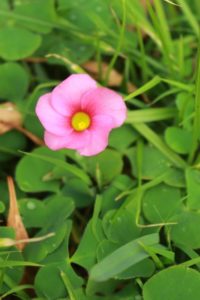

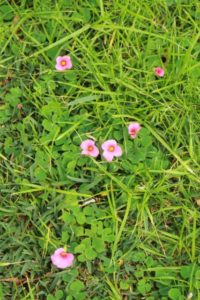
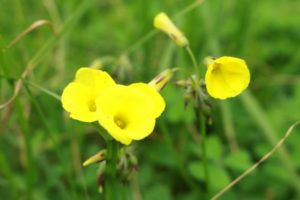
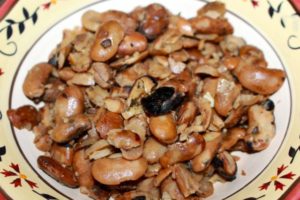
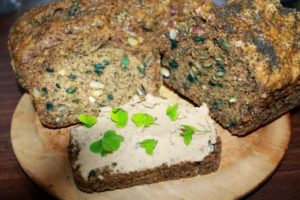




Hi Julia. I met you at a weed workshop in Thames at Jackie’s place. I too, have made the seed bread. I’m on my 3rd loaf and I love it.
Rosalie Howard
Hi Julia, when we were younger 5, 7, 9 my mum used to pound this plant and give it to us to drink whenever we were begin to look as if we had eaten too much sweets etc or grandchildren (surrogate) ones were getting sick, she would pound and squeeze the juice out into a teaspoon or so and if they were babies a few drops into their mouths of this stuff 3 petal (white) flower one don’t know what it is called though… and it used to clear ulcers etc. She said it was the same plant they had in Tonga called kihikihi.
Thanks for your great blog. You say that you don’t use linseed, I was wondering what the reason was.
HI Florence, thanks for your question. Linseed for some reason gives me a dry throat. It is nothing serious but I prefer chia seed. In saying that if linseed is in something I eat it.
Best wishes
Thanks Julia for your post, it will make me appreciate Oxalis more now I know it can be eaten. Are there any recipes that could use the bulb? Like a soup? Or roasted?